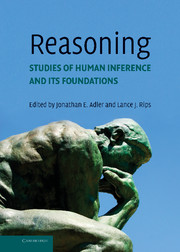Book contents
- Frontmatter
- Contents
- Preface
- List of Contributors
- Introduction: Philosophical Foundations
- PART I FOUNDATIONS OF REASONING
- PART II MODES OF REASONING
- PART II INTERACTIONS OF REASONING IN HUMAN THOUGHT
- Section 9 Reasoning and Pragmatics
- Section 10 Domain-Specific, Goal-Based, and Evolutionary Approaches
- Section 11 Reasoning and Cultures
- 47 Reasoning across Cultures
- 48 Culture and Systems of Thought: Holistic versus Analytic Cognition
- 49 On the Very Idea of a Conceptual Scheme
- 50 The Truth in Relativism
- Section 12 Biology, Emotions, and Reasoning
- Index
- References
48 - Culture and Systems of Thought: Holistic versus Analytic Cognition
Published online by Cambridge University Press: 05 June 2012
- Frontmatter
- Contents
- Preface
- List of Contributors
- Introduction: Philosophical Foundations
- PART I FOUNDATIONS OF REASONING
- PART II MODES OF REASONING
- PART II INTERACTIONS OF REASONING IN HUMAN THOUGHT
- Section 9 Reasoning and Pragmatics
- Section 10 Domain-Specific, Goal-Based, and Evolutionary Approaches
- Section 11 Reasoning and Cultures
- 47 Reasoning across Cultures
- 48 Culture and Systems of Thought: Holistic versus Analytic Cognition
- 49 On the Very Idea of a Conceptual Scheme
- 50 The Truth in Relativism
- Section 12 Biology, Emotions, and Reasoning
- Index
- References
Summary
The British empiricist philosophers of the 18th and 19th centuries, including Locke, Hume, and Mill, wrote about cognitive processes as if they were the same for all normal adults. This assumption of universality was adopted by mainstream psychology of the 20th century, where it has been predominant from the earliest treatment of cognitive psychology by Piaget, to mid-century learning theorists, to modern cognitive science. The assumption of universality was probably strengthened by the analogy to the computer, which has been implicit and often explicit for the past 30 years (Block, 1995; Shweder, 1991). Brain equals hardware, inferential rules and data processing procedures equal the universal software, and output equals belief and behavior, which can, of course, be radically different given the different inputs possible for different individuals and groups. “Basic” processes such as categorization, learning, inductive and deductive inference, and causal reasoning are generally presumed to be the same among all human groups.
It appears, however, that fairly marked differences in knowledge about and use of inferential rules exist even among educated adults. Work by Nisbett and his colleagues (Larrick, Nisbett, & Morgan, 1993; Nisbett, 1993; Nisbett, Fong, Lehman, & Cheng, 1987; Smith, Langston, & Nisbett, 1992) shows that people can learn statistical, probabilistic, methodological, logical, deontic, cost-benefit, and other quite abstract rule systems and categorization procedures, and that training can affect their reasoning about everyday life events and even their behavior.
- Type
- Chapter
- Information
- ReasoningStudies of Human Inference and its Foundations, pp. 956 - 985Publisher: Cambridge University PressPrint publication year: 2008
References
- 8
- Cited by



